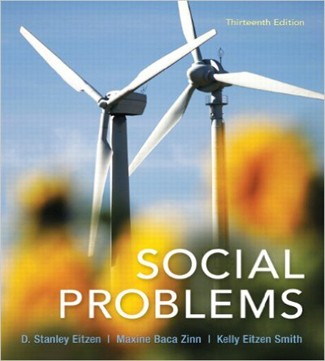Description
ISBN-10: 0205881882
ISBN-13: 9780205881888 978-0205881888
Chapter 1 The Sociological Approach to Social Problems
A. Multiple-Choice
1. As the percentage of the U.S. residents who are over 65 years old increases, the divide between workers who support the old with payroll taxes will have a racial dimension because the elderly will be overwhelmingly __________.
A) African American
B) Asian
C) Latin American
D) White
Answer: D
Page Reference: 3
Learning Objective:
Topic/A-head: Introduction
Skill Level: Remember the Facts
2. Emergency food requests and people seeking emergency shelter are __________.
A) increasing
B) decreasing
C) staying the same
D) not currently studied
Answer: A
Page Reference: 4
Learning Objective:
Topic/A-head: Introduction
Skill Level: Remember the Facts
3. The United States, with about 4.5 percent of the world’s population, consumes __________ of the world’s energy.
A) one-third
B) one-fourth
C) one-half
D) three-fourths
Answer: B
Page Reference: 4
Learning Objective:
Topic/A-head: Introduction
Skill Level: Remember the Facts
4. Based on the measures used in the text, which of the following is the most accurate?
A) A greater proportion of the government is run by women in the United States than in Scandinavian countries.
B) The United States was among the worst countries in the rate of deaths for children under age five.
C) Japan is the best country in the world in which to be a mother.
D) Women have it better in the United States than in any other country in the world.
Answer: B
Page Reference: 5
Learning Objective:
Topic/A-head: Introduction
Skill Level: Remember the Facts
5. Almost all the growth in the world’s population by 2050 will take place in the __________.
A) poorest nations
B) wealthiest nations
C) United States
D) European Union
Answer: A
Page Reference: 5
Learning Objective:
Topic/A-head: Introduction
Skill Level: Remember the Facts
6. Half of the people in the world live on less than __________.
A) $0.25 a day
B) $0.50 a day
C) $1 a day
D) $2 a day
Answer: D
Page Reference: 5
Learning Objective:
Topic/A-head: Introduction
Skill Level: Remember the Facts
7. The __________ nature of social problems illustrates that social problems vary by time, place, and definition.
A) economic
B) objective
C) political
D) subjective
Answer: D
Page Reference: 7
Learning Objective: 1.1
Topic/A-head: History of Social Problems Theory
Skill Level: Understand the Concepts
8. In the most recent direction of the study of deviance, __________.
A) labeling people as abnormal has helped to clarify that they are the source of most social problems
B) it is understood that social structures contribute to the perpetuation of deviance
C) it is understood that deviants bring their problems on themselves
D) labeling is seen as irrelevant in creating and sustaining deviance
Answer: B
Page Reference: 7
Learning Objective: 1.1
Topic/A-head: History of Social Problems Theory
Skill Level: Understand the Concepts
9. The __________ nature of social problems describes societal conditions that harm certain segments of the population.
A) economic
B) objective
C) political
D) subjective
Answer: B
Page Reference: 8
Learning Objective: 1.2
Topic/A-head: Toward a Definition of Social Problems
Skill Level: Understand the Concepts
10. According to the text, __________ often escape criticism and identification as social problems.
A) institutions
B) criminals
C) the mentally ill
D) school dropouts
Answer: A
Page Reference: 9
Learning Objective: 1.2
Topic/A-head: Toward a Definition of Social Problems
Skill Level: Apply What You Know
11. Which of the following is a danger associated with relying on public opinion to define social phenomena as social problems?
A) It may increase focus on intuitions as the source of social problems.
B) It may divert attention from problems within the existing social order.
C) It may overlook conditions that are detrimental to the rich.
D) It may overlook individual responsibility.
Answer: B
Page Reference: 8-9
Learning Objective: 1.2
Topic/A-head: Toward a Definition of Social Problems
Skill Level: Analyze It
12. The nations of Western Europe, Scandinavia, and Canada are able to provide generous social welfare policies for their citizens because they __________.
A) are monarchies
B) tax their citizens at a higher rate than the United States
C) restrict the freedoms of their citizens
D) are communist nations
Answer: B
Page Reference: 11
Learning Objective: 1.3
Topic/A-head: Types of Social Problems
Skill Level: Remember the Facts
13. As a result of extensive and universal social services, the social welfare states have __________ than the United States.
A) higher infant mortality rates
B) lower literacy rates
C) lower rates of violent crime
D) higher rates of violent crime
Answer: C
Page Reference: 11
Learning Objective: 1.3
Topic/A-head: Types of Social Problems
Skill Level: Remember the Facts
14. Social welfare states have a(n) ________ life expectancy when compared to the United States.
A) shorter
B) longer
C) identical
D) nonexistent
Answer: B
Page Reference: 11
Learning Objective: 1.3
Topic/A-head: Types of Social Problems
Skill Level: Remember the Facts
15. Citizens in social welfare states likely have better health outcomes than those in the United States because __________.
A) they provide more tax-funded social services for their people
B) they have no unemployment
C) they have a more competitive system for social services
D) they access social services through private enterprise, which ensures higher quality
Answer: A
Page Reference: 11
Learning Objective: 1.3
Topic/A-head: Types of Social Problems
Skill Level: Remember the Facts
16. According to the sociological perspective, norm violators are __________.
A) solely responsible for their actions
B) universally criticized
C) the symptoms of social problems, not the cause
D) guiltless for their actions
Answer: C
Page Reference: 9
Learning Objective: 1.3
Topic/A-head: Types of Social Problems
Skill Level: Understand the Concepts
17. Society-induced conditions that harm any segment of the population, and acts and conditions that violate the norms and values found in society, define __________.
A) social problems
B) self-actualization
C) cultural deprivation
D) the sociological imagination
Answer: A
Page Reference: 10
Learning Objective: 1.3
Topic/A-head: Types of Social Problems
Skill Level: Understand the Concepts
18. According to the text, the key to understanding social problems is understanding the __________.
A) opinions of the public
B) personal experiences of those who violate society’s norms
C) needs of victims of deviant behavior
D) distribution of power in society
Answer: D
Page Reference: 10
Learning Objective: 1.3
Topic/A-head: Types of Social Problems
Skill Level: Understand the Concepts
19. Institutionalized deviance results in a society in which __________.
A) all law enforcement is corrupt
B) there is an extremely high rate of crime
C) some members are disadvantaged
D) all members are economically equal
Answer: C
Page Reference: 10
Learning Objective: 1.3
Topic/A-head: Types of Social Problems
Skill Level: Understand the Concepts
20. Sociology is distinct from other disciplines in its approach to understanding norm violations as __________.
A) defined by the least powerful members of society
B) culturally defined and socially labeled
C) an inherent property of deviant individuals
D) universally agreed upon
Answer: B
Page Reference: 9
Learning Objective: 1.3
Topic/A-head: Types of Social Problems
Skill Level: Apply What You Know
21. Which of the following is an example of institutionalized deviance?
A) The equal distribution of health care among all members of society
B) The equal distribution of income among all members of society
C) The bias against the poor and people of color by police officers
D) Tax laws that permit a large business to write off purchases
Answer: D
Page Reference: 10
Learning Objective: 1.3
Topic/A-head: Types of Social Problems
Skill Level: Analyze It
22. The idea of the “sociological imagination” was developed by which sociologist?
A) C. Wright Mills
B) William Graham Sumner
C) Karl Marx
D) Emile Durkheim
Answer: A
Page Reference: 11
Learning Objective: 1.4
Topic/A-head: The Sociological Imagination
Skill Level: Remember the Facts
23. The sociological imagination involves which of the following components?
A) A focus on your individual point of view
B) A focus on genetic determinants
C) A focus on social, economic, and historical circumstances
D) A focus on individual decision making
Answer: C
Page Reference: 11-12
Learning Objective: 1.4
Topic/A-head: The Sociological Imagination
Skill Level: Understand the Concepts
24. The system-blame approach assumes that social problems results from __________.
A) psychological conditions
B) social conditions
C) religious tradition
D) institutionalized deviance
Answer: B
Page Reference: 12
Learning Objective: 1.5
Topic/A-head: Social Structure as the Basic Unit of Analysis
Skill Level: Understand the Concepts
25. The assumption by the members of a group that the culture of some other group is not only inferior, but also deficient, is called __________.
A) system-blame
B) person-blame
C) cultural deprivation
D) sociological imagination
Answer: C
Page Reference: 12-13
Learning Objective: 1.5
Topic/A-head: Social Structure as the Basic Unit of Analysis
Skill Level: Understand the Concepts
26. Recidivism is the __________ crime.
A) reinvolvement in
B) retribution for
C) institutionalized deviance of
D) cultural deprivation of
Answer: A
Page Reference: 13
Learning Objective: 1.5
Topic/A-head: Social Structure as the Basic Unit of Analysis
Skill Level: Understand the Concepts
27. The belief that the place of people in the stratification system is a function of their ability and effort refers to __________.
A) self-actualization
B) social Darwinism
C) the subjective nature of social problems
D) the objective nature of social problems
Answer: B
Page Reference: 14
Learning Objective: 1.5
Topic/A-head: Social Structure as the Basic Unit of Analysis
Skill Level: Understand the Concepts
28. Relying too heavily on a person-blame approach to social problems is a problem because __________.
A) it legitimizes the right to initiate system-change rather than person-change
B) societal conditions (such as norms that are racist, sexist, or homophobic) go unchallenged
C) it directs blame at the system and away from the individuals
D) it absolves individuals from responsibility for their actions
Answer: B
Page Reference: 14-15
Learning Objective: 1.5
Topic/A-head: Social Structure as the Basic Unit of Analysis
Skill Level: Understand the Concepts
29. According to social Darwinism, disadvantaged members of society __________.
A) do not have any control over their circumstances
B) are valuable parts of the community
C) deserve government welfare
D) deserve their fate
Answer: D
Page Reference: 14
Learning Objective: 1.5
Topic/A-head: Social Structure as the Basic Unit of Analysis
Skill Level: Understand the Concepts
30. The person-blame approach assumes that social problems results from __________.
A) psychological conditions
B) social conditions
C) religious tradition
D) institutionalized deviance
Answer: A
Page Reference: 12
Learning Objective: 1.5
Topic/A-head: Social Structure as the Basic Unit of Analysis
Skill Level: Apply What You Know
31. Which of the following is a reason for using the system-blame approach in studying social problems?
A) Individual actors are the source of many social problems.
B) A balance is needed since most people in our society tend to blame institutions.
C) It is a necessary first step in restructuring society along more humane lines.
D) Citizens are eager for societal change.
Answer: C
Page Reference: 14-15
Learning Objective: 1.5
Topic/A-head: Social Structure as the Basic Unit of Analysis
Skill Level: Apply What You Know
32. Relying too heavily on a system-blame approach is a problem because __________.
A) societal conditions are taken for granted and go unchallenged
B) it focuses on person-change rather than system-change
C) it directs blame at individuals and away from the system
D) it absolves individuals from responsibility for their actions
Answer: D
Page Reference: 14-15
Learning Objective: 1.5
Topic/A-head: Social Structure as the Basic Unit of Analysis
Skill Level: Apply What You Know
33. A person-blame approach advocates social programs that __________.
A) seek to control individual behavior
B) produce sweeping social change
C) reorganize social institutions
D) change long-held societal norms
Answer: A
Page Reference: 13-14
Learning Objective: 1.5
Topic/A-head: Social Structure as the Basic Unit of Analysis
Skill Level: Apply What You Know
34. Deviant people are treated as the cause of their own problems by which of the following approaches to studying social problems?
A) self-actualization
B) person-blame
C) system-blame
D) institutionalized deviance
Answer: B
Page Reference: 13-14
Learning Objective: 1.5
Topic/A-head: Social Structure as the Basic Unit of Analysis
Skill Level: Apply What You Know
35. Asserting that “the poor are poor because they are not bright enough to succeed” might be said by a __________.
A) social Darwinist
B) sociologist
C) person who focuses on institutionalized deviance
D) system blamer
Answer: A
Page Reference: 15
Learning Objective: 1.5
Topic/A-head: Social Structure as the Basic Unit of Analysis
Skill Level: Apply What You Know
36. Asserting that “the poor are poor because the institutions around them set them up to fail” might be said by a __________.
A) social Darwinist
B) system blamer
C) person who focuses on norm violators
D) victim blamer
Answer: B
Page Reference: 15
Learning Objective: 1.5
Topic/A-head: Social Structure as the Basic Unit of Analysis
Skill Level: Apply What You Know
37. According to William Graham Sumner, the rich are successful because __________.
A) they are superior
B) they have worked the hardest
C) there is a conspiracy by the powerful who keep the poor down
D) they have helped the poor
Answer: A
Page Reference: 15
Learning Objective: 1.5
Topic/A-head: Social Structure as the Basic Unit of Analysis
Skill Level: Analyze It
38. The system-blame orientation would attribute students’ failure in schools to __________.
A) being born with limited intellectual capacities
B) the failure of the students to work hard to succeed
C) the failure of the educational system to meet their needs
D) the failure of their parents to provide proper guidance
Answer: C
Page Reference: 12-13
Learning Objective: 1.5
Topic/A-head: Social Structure as the Basic Unit of Analysis
Skill Level: Analyze It
39. Which of the following would be a reason for a recently released criminal committing another crime according to the system-blame approach?
A) The person did not reform in prison.
B) The person is surrounded by ex-criminals.
C) The person is inherently criminal.
D) Many employers do not hire ex-convicts.
Answer: D
Page Reference: 13-14
Learning Objective: 1.5
Topic/A-head: Social Structure as the Basic Unit of Analysis
Skill Level: Analyze It
40. According to the system-blame approach, many ex-convicts can be seen as victims in that __________.
A) they were born deviant
B) they have to spend time in prison for their crimes
C) they do not have the skills and resources to survive without resorting to crime
D) they are required to spend a year in school after getting released from prison
Answer: C
Page Reference: 13
Learning Objective: 1.5
Topic/A-head: Social Structure as the Basic Unit of Analysis
Skill Level: Analyze It
41. According to the sociological perspective, which of the following best explains social problems?
A) Norm violators
B) People who seek self-actualization
C) Problems caused by societal conditions
D) Biology
Answer: C
Page Reference: 14-15
Learning Objective: 1.5
Topic/A-head: Social Structure as the Basic Unit of Analysis
Skill Level: Analyze It
42. Our social system is rarely seen as causing social problems because __________.
A) it is the poor who define what are considered social problems
B) we tend to focus on the elite who commit “deviant” acts
C) institutions cannot be changed
D) we have a hard time questioning our cherished traditions
Answer: D
Page Reference: 14-15
Learning Objective: 1.5
Topic/A-head: Social Structure as the Basic Unit of Analysis
Skill Level: Analyze It
43. Social Darwinists would oppose social reforms like social welfare because __________.
A) they are too expensive to produce viable results
B) they allow people to get money for doing nothing
C) they perpetuate the existence of unfit groups in society
D) it is more effective to provide technical training for the poor







Reviews
There are no reviews yet.